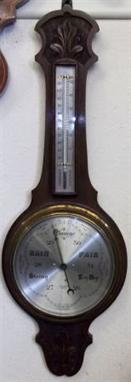23431 Preisdatenbank Los(e) gefunden, die Ihrer Suche entsprechen
23431 Lose gefunden, die zu Ihrer Suche passen. Abonnieren Sie die Preisdatenbank, um sofortigen Zugriff auf alle Dienstleistungen der Preisdatenbank zu haben.
Preisdatenbank abonnieren- Liste
- Galerie
-
23431 Los(e)/Seite
A STICK BAROMETER by Charles Aiano, Northgate, Canterbury (fl 1826-1841), with thermometer, silvered register and exposed mercury tube, the mahogany case with feather banding and chequer stringing, the broken pediment with turned brass finial, moulded sides, and circular cistern cover with inlaid ebony and ivory roundel, 38 1/2" high
A mid-19th Century Rosewood and Boxwood Line Inlaid Wheel Barometer, the swan neck pediment with central urn-shaped finial to a baluster neck with hygrometer to detachable single scale alcohol thermometer, to a mirror aperture (mirror lacking), to a spun brass bezel enclosing a 10” silvered dial with scale of 28-31 over a level, height 42”
A DERBYSHIRE COLOURED HARDSTONE INLAID BLACK `MARBLE` THERMOMETER of arched shape framed by fuchsia, on stepped base, 18cm h, c1870 In good original condition with tiny loss to the stems of one or two of the fuchsia, lacking one of the four screws which secures the glass thermometer tube to the ivory scale. No restoration
A MAHOGANY STICK BAROMETER the open triangular pediment with gilt brass pineapple finial, the silvered register plate signed...26 Holborn London, with vernier, hygrometer and thermometer, turned cistern cover, 100cm h, 19th c and later Extensively restored and made up from early 19th c elements in the 20th c but of satisfactory appearance
A FRENCH SILVERED BRASS DESK TIMEPIECE-BAROMETER the enamelled dials inscribed CORRALL CONGLETON or ANEROID BAROMETER in gilt bezels divided by a mercury thermometer, the dial-plate engraved with flowers in double carriage type case with swing handle, 12.5cm h excluding handle, early 20th c The lacquer on the exterior worn and discoloured, timepiece with replaced escapement
A VICTORIAN GOTHIC OAK STICK BAROMETER the ivory register plates signed Carpenter & Westley 24 Regent Street London 10AM Yesterday 10AM To Day, with verniers, the mercury thermometer also signed, the carved and lancet arched case with waterleaf and applied mouldings, 106cm h, maker`s printed label of DIRECTIONS FOR HANGING CARPENTER & WESTLEY`S PORTABLE BAROMETER pasted on the reverse In good original condition with some accretion of dirt and grime, retaining both of the original detachable knobs, one lacking the ivory bush, partly in an old dark brown stain which is chipped and worn but entirely original. The tube original and charged with mercury
AN EARLY VICTORIAN MAHOGANY STICK BAROMETER signed on the engraved and silvered register plate Cary London with vernier, lacquered brass cap and mercury thermometer, having pagoda pediment and bun cistern cover, 96cm h The silvering on the dial unevenly discoloured, the mahogany repolished. It is not charged with mercury.
19th Century Anglo-Indian mother-of-pearl, abalone shell and brass inlaid hardwood cased stick barometer by T. Wheelhouse of Hatton Garden, London, shaped arch pediment, allover foliate bird and ribbon decoration, ivory register plates with double rack and pinion Vernier scale, fahrenheit and Reaumer thermometer, cushion shaped cistern cover, 114cm high.
The important memoirs of Peter Crosthwaite, a bound handwritten manuscript by Peter Crosthwaite, 56 pages. The memoirs were written "in an attempt to vindicate his character. Many scandalous and malicious reports had been propagated against him". The memoirs were an attempt to prove the worth of his character from the date of his birth until his Court Martial whilst serving with the East India Company and prior to his return to Keswick and setting up the Keswick Museum. The memoir is also sold with a letter from the Quaker Professor John Gough to Peter Crosthwaite at the museum, Keswick. The letter discusses John Dalton (the discoverer of atomic theory) and notes that he was engaged in the same pursuit, namely the observation of the Aurora Borealis and the effects thereupon of changes in the weather. The letter discusses the thermometer, quantity of rain and comparative states of the atmosphere in respect to humidity, etc. It also discusses methods of measuring the rain and moisture content of air. The letter discusses John Dalton (the discoverer of atomic theory) and notes that he was engaged in the same pursuit, namely the observation of the Aurora Borealis and the effects thereupon of changes in the weather. The letter discusses the thermometer, quantity of rain and comparative states of the atmosphere in respect to humidity, etc. It also discusses methods of measuring the rain and moisture content of air. The letter is dated Kendal 21st March 1788. PROVENANCE - the memoir of Peter Crosthwaite manuscript and the letter from John Gough to Peter Crosthwaite have both been on loan to The Wordsworth Trust, Dove Cottage, Grasmere.
-
23431 Los(e)/Seite























































